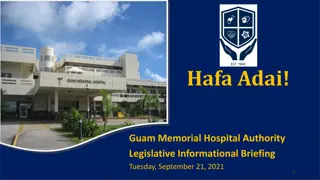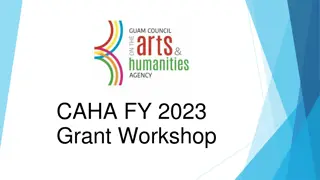Bridging Fiscal Opportunities in Guam: Plenary Session Insights
Delve into the discussion from the Plenary Session V on bridging fiscal opportunities in Guam, featuring key figures like Kate Baltazar and Troy Torres. Insights on historical perspectives, functions, training needs, and more are explored with a focus on enhancing budgetary planning. Discover how federal and local policies influence budget allocation and strategic planning efforts in Guam.
Download Presentation

Please find below an Image/Link to download the presentation.
The content on the website is provided AS IS for your information and personal use only. It may not be sold, licensed, or shared on other websites without obtaining consent from the author.If you encounter any issues during the download, it is possible that the publisher has removed the file from their server.
You are allowed to download the files provided on this website for personal or commercial use, subject to the condition that they are used lawfully. All files are the property of their respective owners.
The content on the website is provided AS IS for your information and personal use only. It may not be sold, licensed, or shared on other websites without obtaining consent from the author.
E N D
Presentation Transcript
PLENARY SESSION V (BRIDGING FISCAL OPPORTUNITIES) Kate Baltazar Administrator Guam State Clearinghouse Troy Torres Governor s Strategic Planning Advisor Imagine Guam Initiative John A.B. Pangelinan Budget and management Analyst Supervisor Bureau of Budget and Management Research
PLENARY SESSION V (BRIDGING FISCAL OPPORTUNITIES) Kate Baltazar Administrator Guam State Clearinghouse
KATE G. BALTAZAR ADMINISTRATOR
Historical Perspective Federal - Presidential Executive Order 12372 signed in 1983 by then-President Ronald Reagan Local - Title 5 GCA, 1983 - placed under the purview of the Office of the Lt. Governor of Guam
Functions Intergovernmental Review Monitoring and Compliance / Advocacy Training & Development
Training Grantwriting Grants Management Project Management Strategic Planning Other
BSP Planners Training Needs Assessment Survey
PLENARY SESSION V (BRIDGING FISCAL OPPORTUNITIES) Troy Torres Governor s Strategic Planning Advisor Imagine Guam Initiative
PLENARY SESSION V (BRIDGING FISCAL OPPORTUNITIES) John A.B. Pangelinan Budget and Management Analyst Supervisor Bureau of Budget and Management Research
Prelude The Bureau of Budget and Management Research s (BBMR) presentation today is based on the budgetary planning of a line department or agency of the Executive Branch. It does not focus on the qualitative aspects of the island s environment; but the budgetary process presented today can be applied to those environmental programs seeking local and federal funding. However, BBMR is of the opinion that any enhancement to Guam s environment that could co-exist with existing economic infrastructure, resulting in increased tax revenues, would be most welcomed.
The Budget Process: Strategic Planning for Results Introduction Mission Statement Program Objectives Strategic Goals
The Budget Process: Strategic Planning for Results Mission Statement (Why was the agency established?) Validation Enabling Legislation Other Legislations mandating specific performance Governor s Executive Order (s) Organizational Chart Divisional Breakdowns Workloads Various Tasks and Activities
The Budget Process: Strategic Planning for Results - Mission Statement [BBMR AN-N1] Government of Guam Fiscal Year 2017 Budget Department / Agency Narrative FUNCTION: _______________________________ DEPT. / AGENCY: _______________________________ MISSION STATEMENT: GOALS AND OBJECTIVES:
The Budget Process: Strategic Planning for Results Program Objectives Divisional Breakdown = Major Program Sectional Program Objective Workload Indicators Task or Activity 1: Number accomplishment and Unit Cost More than 1 Task or Activity
The Budget Process: Strategic Planning for Results Program Objectives
The Budget Process: Strategic Planning for Results Workload Output
The Budget Process: Strategic Planning for Results Work Load Outputs Work Load Outputs (Indicators) Identify tasks that quantitatively address the level of accomplishment from the previous fiscal year. To accomplish such objective, a historic view must be made for the number of tasks accomplished for the year and the cost of such tasks based on the following chronology. The increase or decrease of each task using FY 2015 as the baseline. The increase or decease of each task for FY 2015 from FY 2014 for FY 2016. The increase or decrease of each task for FY 2016 from FY 2015 for FY 2014 The proposed task activities for both cost and quantity of each task in FY 2017, given the review made (Program Objectives for FY 2017).
The Budget Process: Strategic Planning for Results Work Load Outputs Once the work load indicators have been identified, the performance standard for FY 2017 is then identified and must be expressed either as an increase or decrease in percentage, dollars or task units the previous year. Monitor objectives to determine whether or not proposed increases or decreases in work output is taking place (reporting system of tracking expectation against actual results). Manage program objectives by identifying problem and providing solutions within the program so that expectations for that year are met.
The Budget Process: Strategic Planning for Results Strategic Planning. Strategic Planning Sum of all proposed work outputs for the coming fiscal year by a departmental division or a combination of some or all divisions of an organizations. Analyze impact of the proposed work outputs to determine outcome that could be either quantified or qualified appropriately. Write the strategic goal or goals of the department for the coming fiscal year,
Budget Process: Strategic Planning for Results Strategic Goals Strategic Goal (s) Appointing Authority, Director or Administrator, etc. determines the upcoming goals of the department based on the past performance of the department. It is his or her vision of the accomplishment (s) that will take place in the coming fiscal year. Success or failure on achieving desired results is dependent on the proper monitoring and managing of program objectives.
Summary Review the departmental Mission Statement to determine if updates are required based on new legislative mandates and Executive Orders. Review your organizational chart to ensure your Mission Statement is in line with the current chart. Review the department s divisional programs and their corresponding work- outputs to determine past and current performance. Develop performance expectations for new fiscal year.
Summary Develop reporting system to track expectation to actual in new fiscal year. Formulate the strategic plan based on expected outcomes. Analyze overall strategic plan Write Strategic Goals Analyze tracking reports for progress throughout the fiscal year.























